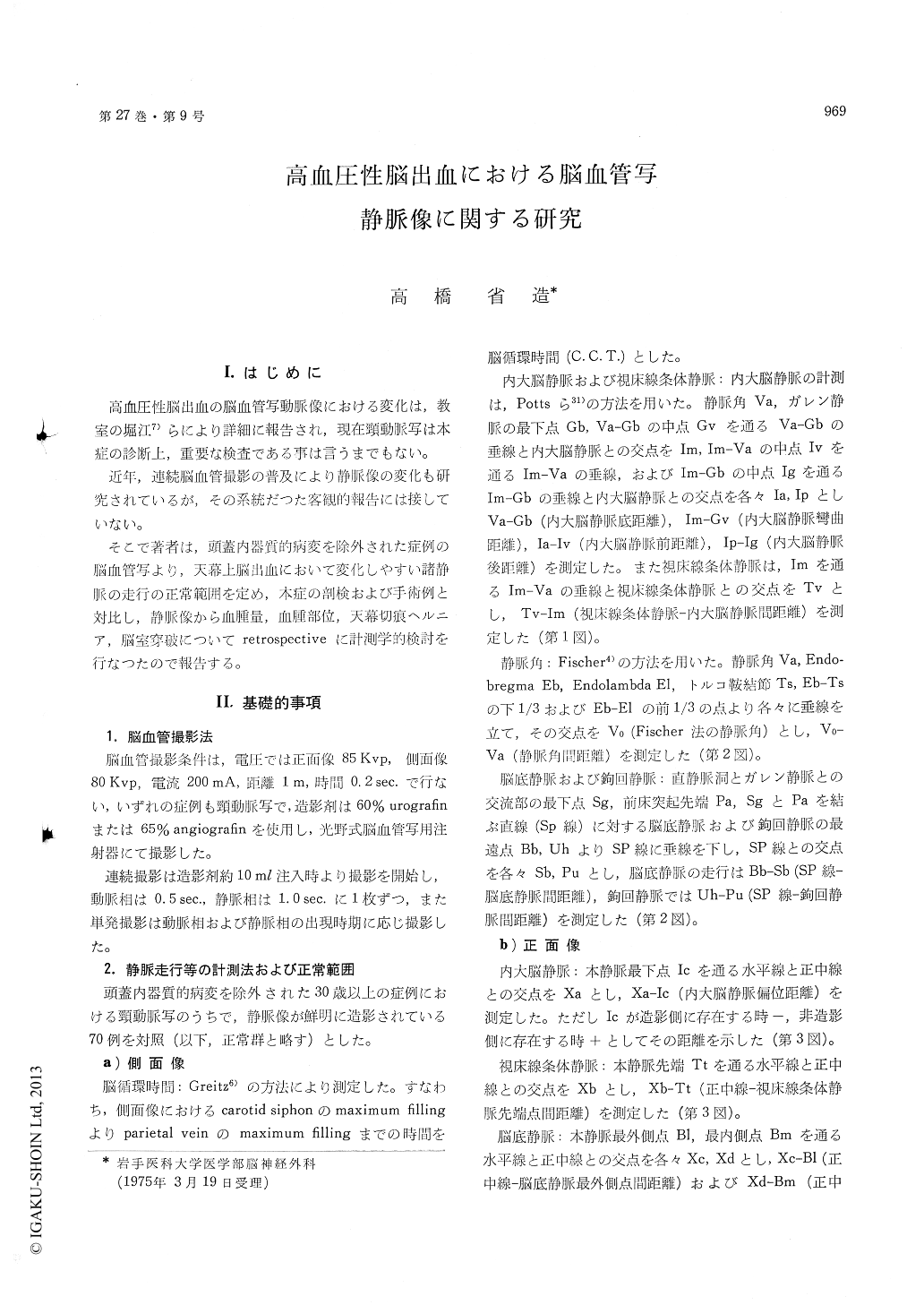Japanese
English
- 有料閲覧
- Abstract 文献概要
- 1ページ目 Look Inside
I.はじめに
高血圧性脳出血の脳血管写動脈像における変化は,教室の堀江7)らにより詳細に報告され,現在頸動脈写は本症の診断上,重要な検査である事は言うまでもない。
近年,連続脳血管撮影の普及により静脈像の変化も研究されているが,その系統だつた客観的報告には接していない。
そこで著者は,頭蓋内器質的病変を除外された症例の脳血管写より,天幕上脳出血において変化しやすい諸静脈の走行の正常範囲を定め,本症の剖検および手術例と対比し,静脈像から血腫量,血腫部位,天幕切痕ヘルニア,脳室穿破についてretrospectiveに計測学的検討を行なつたので報告する。
In the acute stage of hypertensive intracerebralhemorrhage, at the present, the cerebral angio-graphical examination is very important in decidingthe indication for surgical treatment and estimatingthe prognosis of the patient. The arterial phaseof cerebral angiogram in the condition has beeninvestigated in detail by several investigators.However, the venous phase has been little studiedup to the present. For this reason, the authorcarried out cerebral phlebographic studies on patientswith hypertensive intracerebral hemorrhage ad-mitted to our department, during the last decade.Clinico-pathological data and cerebral phlebogramsof 58 patients were examined to estimate the he-matoma volume, the type of hematoma and thepresence of tentorial herniation or ventricular hem-orrhage, which were confirmed by autopsy in 12patients and by operation only in 46.
The type of hematoma was devided into twogroups: the lateral type or the combined type ac-cording to Scheinker's classification. In this series,39 cases were the lateral type and the remaining19 were the combined type. Cerebral angiographywas performed within 24 hours after the ictus ofhemorrhage in 38 patients (65.5%).
The results obtained are as follows:
1. In cases of hemorrhage without herniation,the hematoma volume can be estimated by measur-ing the displacement of the most lateral point ofthe basal vein and that of the internal cerebralvein in A-P view from each regression line in thediagram. On the other hand, in cases of hemorrhagewith herniation, the volume can be estimated bymeasuring the circulation time in angiograms inaddition to the displacement of the internal cerebralvein from the regression line. The error rangewas less than 20 ml in cases of hemorrhage with-out herniation and less than 35 ml with herniation.
2. Marked difference was noted in the shape ofinternal cerebral vein in lateral view between thelateral type and combined type of hypertensiveintracerebral hematoma. The curve of the anteriorpart of the internal cerebral vein did not showremarkable changes in the lateral type, but thecurve was flattened in the combined type.
3. Tentorial herniation can be diagnosed bymeasuring the displacement of the basal vein andthe uncal vein in lateral view, and also the dis-placement of the basal vein in A-P view. Thedisplacement was decided by measuring the distancefrom the SP line, which runs from the anteriorclinoid process and the lowest point of the junctureof the straight sinus with the vein of Galen. Ifany of the following conditions is confirmed, it isevidence of the occurrence of tentorial herniationor at least danger of herniation.
1) The distance from the SP line to the basalvein is more than 10.0mm in lateral view.
2) The distance from the SP line to the uncalvein is less than 4.1mm in lateral view.
3) The distance from the midline to the mostlateral point of the basal vein is less than 21.2mm in A-P view.
4) The distance from the midline to the mostmedial point of the basal vein is less than 13.7mmin A-P view.
4. Ventricular hemorrhage can be estimated bymeasuring the difference between the distance ofthe shift of the internal cerebral vein and the dis-tance of the shift of the anterior cerebral arteryin A-P view. When ventricular hemorrhage ispresent, the shift of the internal cerebral vein isgreater than the shift of the anterior cerebral artery,and when this difference exceeds+2.0 mm ven-tricular hemorrhage is present in a high average(more than 90%) of cases.

Copyright © 1975, Igaku-Shoin Ltd. All rights reserved.


